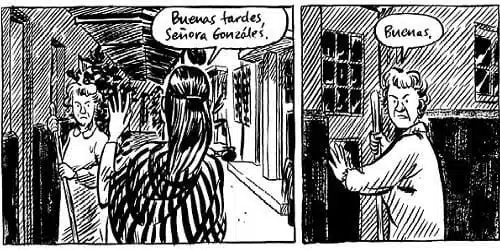
English is, understandably, the norm in American comic books. Even where other languages are implied, by, for example, translation or setting, the differences between reading and listening make the use of English largely acceptable to readers in ways that it may not be on film or in television. Publishing in the intended language may make for a more “authentic” text, but the pointlessness of doing so makes the choice moot. At the same time, there are books where the narrative would seem to demand that readers be shaken out of their linguistic complacency. In La Perdida (Pantheon, 2006), Jessica Abel creatively “draws” dialogue so as to create the illusion of characters speaking in another language even though what’s on the page is largely in English.
Abel’s narrative is about Carla, a young, not quite college graduate from Chicago with an Anglo mother and a Mexican father. Despite being estranged from her father, when she begins questioning her own identity, she travels to Mexico City, where she ends up living for a year. She initially falls in with a group of American ex-pats and then with a circle of Mexican friends and acquaintances. Carla tries desperately to “go native”, but is too unsure of herself to do so on her own terms. Ultimately, her inability or unwillingness to truly give herself over to her new home makes her into a catalyst for tragic events in the lives of those around her.
In American comics, a common strategy for denoting another language is to mark the relevant dialogue in some way, such as with brackets and/or a note, to set it apart from “normal” speech.
However, Abel’s story requires more than dropping in some “Spanish” for local flavor, or to underscore a change in scene. For most of the book, not only is Carla in Mexico, she is also in the process of learning and becoming more comfortable with the language.
In the main part of the book, where Carla is in Mexico City, Abel chooses to reverse the usual terms by making English the marked language, that is, dialogue in English is bracketed while dialogue in Spanish is not.
Because most of the characters are speaking Spanish most of the time, there is a risk that many American readers will forget what the native language is meant to be, but the story ensures that Carla has call to speak English, as when her brother Rodrigo, “Rod”, comes to visit. In such passages, the appearance of bracketed dialogue is a reminder to think “Spanish” when reading “normal” speech. Abel also takes care not to translate certain words into English, especially ones, like the ubiquitous “güey”, that are not easily rendered into another language, particularly not in a colloquial way.
Through the prologue, set in Chicago, and the first chapter of Carla’s time in Mexico City, when she is primarily in the company of other Americans, dialogue is drawn in both languages, with subtitles for Spanish. This strategy both announces that the book is not strictly an English-language text and also emphasizes Carla’s own process of acculturation. When she moves into her own apartment, away from ex-boyfriend, Harry, Spanish is no longer denoted by dialogue in that language, but is indicated by unbracketed English.
While the prologue and an epilogue are set in the present, the events in Mexico City are told in retrospect, and accompanied by “voiceovers” from Carla. While it seems safe enough to assume that these are meant to be in English, the voiceover narration also works as an additional prompt to think about language, and whether certain words should be read as “Spanish” or “English”.
In a prefatory note, Abel states that she “omitted the traditional use of italics for words in foreign languages, as I feel their constant use would be more distracting than helpful”. Likely this is why she also chose not to use subtitles throughout the text as well. In addition, one can imagine how labor-intensive it would have been for the author-artist to hand draw page-after-page of italicized or subtitled dialogue.
The choice to draw, rather than computer-generate, the lettering in La Perdida is also relevant to the text’s effective representation of language. In Drawing Words & Writing Pictures, Abel and co-author Matt Madden argue for hand lettering in comics. They maintain that when letters are “drawn by the same hand that draws the art, the two elements fit together seamlessly. The reader is able to ‘hear’ the dialogue as if it’s spoken by the characters” The organic look and feel of the hand drawn letters in La Perdida is of particular importance because one language, English, is largely asked to stand in for another, Spanish. Making words look as if they “belong” to the characters speaking them is even more crucial here than it is in comics where such connections can be taken for granted.
The overlapping strategies Abel adopts to address the bi-linguality of her narrative serve to bring Spanish to the fore even as the text itself is primarily in English. She is able to underline themes of openness and cultural difference without losing her English reading and speaking audience, while, at the same time, making that audience aware that their language is not naturally the language of most of the text. La Perdida is exceptional in its creative and intelligent handling of linguistic difference, likely de-centering many readers, but without alienating them. Abel’s book shows how the particular art of comics, especially “drawing words”, affords unique opportunities to provocatively play with language.
